Categories: Sharing experience, About electricians and not only
Number of views: 65390
Comments on the article: 7
About electrician's knife (mounting knife)
First, a little about yourself. I am an electrician by profession. He worked for seven years in the housing office. We have such an ominous organization. Now the specifics of my work are a little different, but, nevertheless, questions on the topic "a real electrician's knife" still concern me. So about the specifics. That is, about what makes the situation unique.
Knives are different. Electricians are also different. I write about those electricians (strictly speaking - electricians) who work with a voltage of 220/380 volts with networks of 200 amperes or less. Those. Typical household and zheksky fitters. I won’t lie about other electricians - there’s another story. So here. It’s unlikely that anyone will be very interested in hearing about the installers themselves or ZhEKs, but reading about the super-knife of an electrician can be fun.
The point is again in the specifics. The household-Zhekovsky fitter (abbreviated BZHM) has to work at temperatures from -15 to +40, sometimes in water, in cramped conditions, in the dark, and very often, with live wiring. The latter, it seems, is not supposed to be, but life is such ... So what to work in such conditions? What do knife manufacturers offer us? Nothing good ...
Masterpiece No. 1 - Folding miracle with a black handle
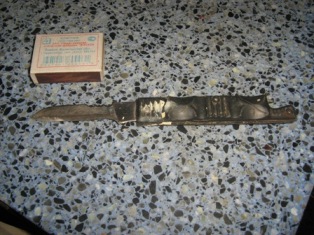
It was produced at the time of the collapse of socialism by an unknown manufacturer ... Folding ... There is no fixation of the blade (so socialism, damn it, was warm ...) The mechanism was broken in a week. Clogged in a day. On the handle only plastic covers that do not give protection against current. Mysterious teeth on the back of the blade. Theoretically, these cloves can:
a) remove scale from wires
b) remove the insulation from the wire.
Both actions can only be done by folding the knife - the blade is not fixed. Which is not convenient. It’s better to just use the blade itself. In addition, when (b) wire metal is damaged. Pros, of course, try to avoid this. On the side opposite the blade, a beer bottle opener is located on the handle. That is what a knife designed under socialism means. Still cared about people ...
There is a variant of such a knife, where instead of an opener a screwdriver is screwed up. But that knife was probably invented in very gloomy times. And the screwdriver there was bespontovaya ...
Knife steel is not suitable for anything. Dull quickly with a burr.
True, there is something good in the knife. The cutting edge is a straight line parallel to the main axis of the knife. What is good in this, I will explain below.
But in general, this knife is not a knife ...
Masterpiece number 2 - Red and black.
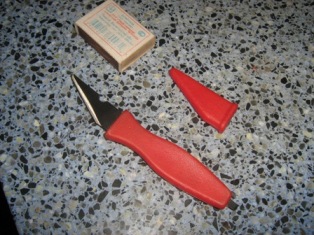
Fresh product is again an unknown domestic manufacturer. The blade is short, the only thing pleases. The cutting edge is made obliquely from the main axis of the knife. It is not comfortable. I will explain further. A screwdriver is made on the back of the handle. You cannot twist large screws - it is not a convenient grip of the handle, but for small screws the size of the working part of the screwdriver is too large. And the funny thing is that this screwdriver is one with the blade, i.e. energized by the blade you can’t work anymore. The handle is made with a claim to anatomy, but due to the fact that the thickness of the handle on the plane is small, the claim remains a claim. A mysterious tooth on the back of the blade is just as necessary as the fifth leg of the dog. Mini-sheath for the blade was attached to the knife. Due to minimalism-anachrenism, they will quickly be lost. I did not use this knife and I do not advise others ...
Other masterpieces.
Unfortunately no photos. Knives made from hacksaw blades are very popular among electricians. The canvas is sharpened in the manner of a shoe knife and wrapped with electrical tape or something like that. Partisanism, of course. The knife is too big, the blade is not sharpened in the best way, but it’s cheap, reliable and more or less practical.
Another masterpiece was issued by foreign manufacturers. In appearance - a typical Finnish puuko, only the plastic handle.The electrical isolation of the handle pleases, but this is where the specificity (specialization) ends. Nearby on a shelf in the store are knives of the same company and a similar type: knives of a carpenter, diver, etc. As>
And now the best electrician’s knife of all time.

When selling, he looked like this:
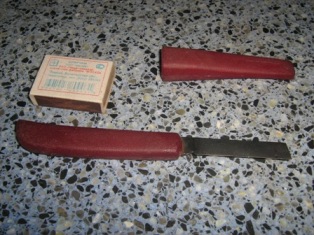
Again, an unknown domestic manufacturer issued this ingenious knife under the guise of some kind of gardening:). (Like all ingenious, they invented it by chance and not for what they wanted). And it was funny - 17 rubles (a year ago). In fact, an electrician cannot find a better knife. Why? I explain.
The knife should generally be small so that you can work quietly in cramped conditions. The blade itself should also be small so as not to cut too much in the confusion of wires. And yet - a short blade feels better with the hand, it is easier to perform small work. The cutting edge is straight and parallel to the main axis of the knife. This simplifies the work of cutting cables in a double sheath - when it is necessary to cut only the outer sheath and not damage the inner one. A knife with a slanting blade is more difficult to do.
By the way, any knife can handle the main task of the knife - wire stripping. This is done like this -

( Not so (cutting insulation around the circumference). I have a suspicion that it is for such an incorrect removal of insulation that mysterious cloves on some "professional" knives are intended. Move on. Handle. Non-anatomical, but tiny (which is important) and convenient. By the touch of the handle, you can easily determine where the cutting edge of the blade is. Naturally the handle is plastic and insulating. Metal blade. Something slightly carbon and heat-treated successfully. Out of modesty, manufacturers did not indicate either their trademark or steel grade. Oddly enough, the electrician does not need a very sharp knife. Firstly, in many operations, the fingers touch the cutting edge, and secondly, an excessively sharp blade can damage the metal of the wire during stripping or catch the wrong insulation when cutting the cable. Such a sharpness of the blade in this knife is mysteriously supported by itself. Not otherwise, some top-secret military developments were used :). Sometimes you just need to slightly adjust the cutting edge on the pebble. The combination of flexibility and hardness is ideal - this knife had to withstand hammer blows. Only he could not bear the blow of the sledgehammer - he was half cut. From this it became even more convenient to use. Miracles do not end there. Sheath. I have not seen a single electrician scabbard, mounted on a belt. Not convenient. But in principle, the sheath is needed. So that the knife in the heap of the tool does not stupid and that from this heap to the touch it can be easily removed. The presented knife has plastic sheaths, which also hide a third of the handle. Fit tightly. Keep tight. They don’t fall off from any vibration. With a flick of the thumb, the hands are easily reset. Ideal ... It remains only to thank the creators of this knife and complain about others - stupid. P.S. As a complement some more photos of knives. In the photo - a knife, referred to in the store as "electrician's knife." However, it is too big and not convenient for delicate work. This is what another “electrician’s knife” looks like. This is better, but its handle is too big: P.S. Be careful when working with the mounting knife: position your hands so that the tool does not jump off and hurts you. Read also on this topic:How to quickly remove insulation from a cable or wire
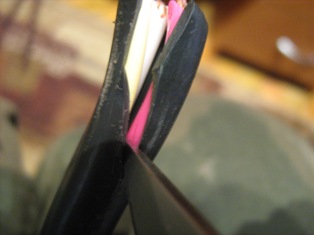
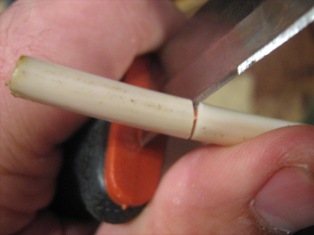

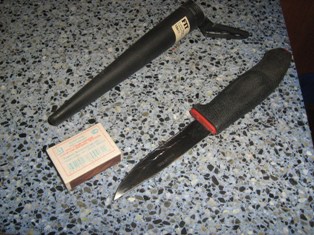
See also at i.electricianexp.com
:
